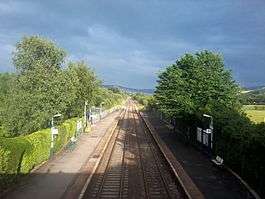Bamford railway station
| Bamford | |
|---|---|
 | |
| Location | |
| Place | Bamford |
| Local authority | High Peak |
| Coordinates | 53°20′20″N 1°41′20″W / 53.3389°N 1.6890°WCoordinates: 53°20′20″N 1°41′20″W / 53.3389°N 1.6890°W |
| Grid reference | SK208825 |
| Operations | |
| Station code | BAM |
| Managed by | Northern |
| Number of platforms | 2 |
| DfT category | F2 |
|
Live arrivals/departures, station information and onward connections from National Rail Enquiries | |
| Annual rail passenger usage* | |
| 2012/13 |
|
| 2013/14 |
|
| 2014/15 |
|
| 2015/16 |
|
| 2016/17 |
|
| History | |
| Original company | Dore and Chinley Railway |
| Pre-grouping | Midland Railway |
| Post-grouping | London, Midland and Scottish Railway |
| 25 June 1894 | Station opened |
| National Rail – UK railway stations | |
| * Annual estimated passenger usage based on sales of tickets in stated financial year(s) which end or originate at Bamford from Office of Rail and Road statistics. Methodology may vary year on year. | |
|
| |
Bamford railway station serves the village of Bamford in the Derbyshire Peak District, in England and is managed by Northern. It is located 13 miles (21 km) west of Sheffield on the Hope Valley Line.
History

Bamford station was built by the Dore and Chinley Railway, a company which was absorbed by the Midland Railway prior to opening. The line was opened for goods traffic on 6 November 1893, and for passenger trains on 1 June 1894, but Bamford station was not opened until 25 June that year.[1][2] The Dore and Chinley line later became known as the Hope Valley Line. The station became an unstaffed halt in 1969 when the last station master purchased the Station House. The main station building was located on the road overbridge, and was removed during the late 1970s.
Derwent Branchline
During the construction of the nearby Derwent and Howden dams between 1912 and 1916, the railway carried stone from a quarry at nearby Grindleford, up a branch line to the worksite. When the dams were completed, the branch line was removed, but later re-instated during the WW2 construction of the Ladybower Reservoir. A signalbox used to control the station and branch line, but this has since been relocated to Peak Rail. The branch line has since been removed, but there is access to the old trackbed as the Thornhill Trail.
Facilities
The station is unmanned as noted, so all tickets must be purchased on the train or in advance of travel. Standard waiting shelters are provided on each platform, whilst train running details are offered via help points, automatic announcements and timetable posters. Step-free access is available to both platforms (the eastbound one via a ramp from Station Road).[3]
Service
All services are provided by Northern except the first (to Liverpool Lime Street) and the last (to Nottingham) which are provided by East Midlands Trains.
Trains from Sheffield take around 22 minutes, and trains from Manchester Piccadilly take around 53 minutes.
Weekdays
- The typical off-peak service from the station includes a train in each direction (west to Manchester Piccadilly via New Mills Central and east to Sheffield) hourly - with minor exceptions. The same also operates on Bank Holidays.[4]
Weekends
- Saturday & Sunday: A train in each direction once every hour
References
- ↑ Awdry, Christopher (1990). Encyclopaedia of British Railway Companies. London: Guild Publishing. p. 71. CN 8983.
- ↑ Butt, R.V.J. (1995). The Directory of Railway Stations. Yeovil: Patrick Stephens Ltd. p. 26. ISBN 1-85260-508-1. R508.
- ↑ Bamford station facilities National Rail Enquiries
- ↑ Table National Rail timetable, May 2017
External links
| Wikimedia Commons has media related to Bamford railway station. |
- Train times and station information for Bamford railway station from National Rail
| Preceding station | Following station | |||
|---|---|---|---|---|
| Northern | ||||
| East Midlands Trains Limited service |